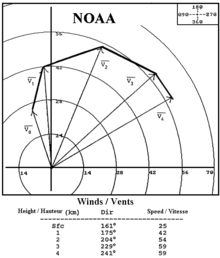Hodograph

The hodograph (from Gr. Hodós "path") of the movement of a particle is the mapping of the speed vector as a function of time, or more precisely: the set of end points of the speed vectors plotted from a fixed point.
It was probably first used by James Bradley , but its practical development and dissemination is mainly due to William Rowan Hamilton , who published a report on it in the Proceedings of the Royal Irish Academy in 1846 .
The definition of the hodograph states that the distance of the curve from the origin always corresponds to the magnitude of the speed and the connecting line from the origin to the point on the curve indicates the direction of the speed of the particle. It follows that the tangent to the Hodograph curve shows the direction of the acceleration of the particle at all times .
See also
literature
- David L. Goodstein, Judith R. Goodstein: Feynman's Lost Lecture: The Movement of Planets Around the Sun , Piper Verlag GmbH, Munich 1998, ISBN 3-492-22994-8 - In this book the hodograph is used to determine the elliptical ( Kepler's) orbits can be derived geometrically from Newton's laws of motion and gravitation .
- William R. Hamilton: The hodograph or a new method of expressing in symbolic language the Newtonian law of attraction Proc. Roy Irish Acad 3, 344-353, 1846.
Web links
- Hodograph . In: Lexicon of Physics . Spectrum Akademischer Verlag, Heidelberg 1998 ( Spektrum.de [accessed on January 23, 2018]).
- JB Calvert: The Hodograph. March 10, 2003, accessed January 23, 2018 .